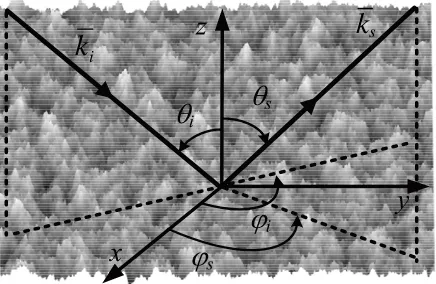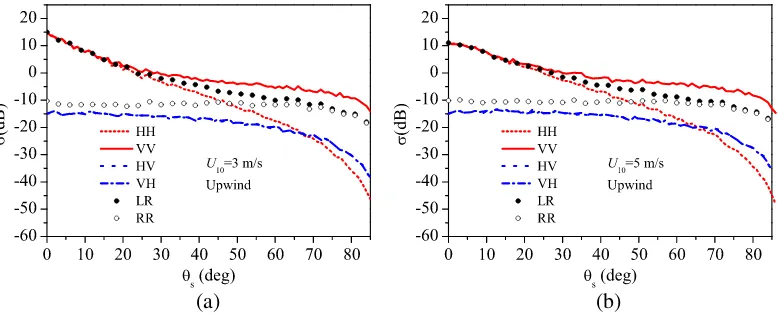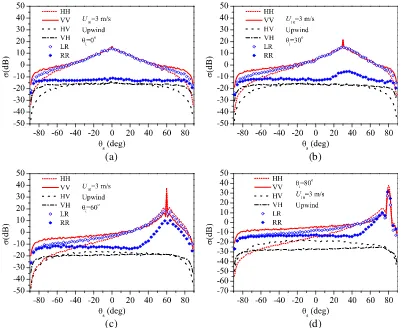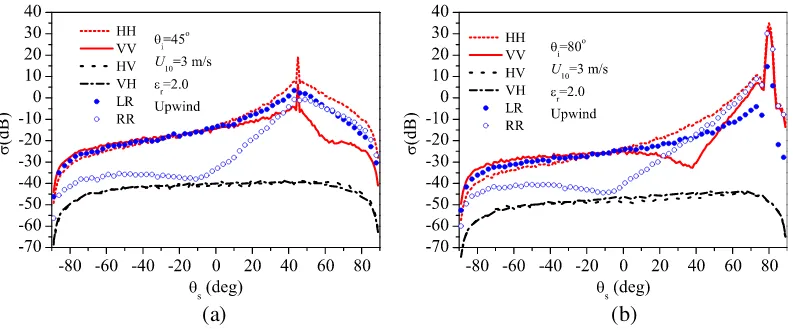Circularly Polarized Wave Scattering from Two-Dimensional
Dielectric Rough Sea Surface
Pengju Yang*, Lixin Guo, and Qiang Wang
Abstract—Based on the polarimetric scattering model of second-order small-slope approximation (SSA-II) with tapered wave incidence under linear and circular polarization, monostatic and bistatic scattering from two-dimensional dielectric rough sea surface is investigated. The emphasis of the present study is on the polarization signature of the scattered wave under circularly polarized wave incidence, which is related to the Brewster angle. Numerical simulations show that for bistatic configuration under circularly polarized wave incidence, the polarization state of scattering wave strongly depends on incident angle, scattering angle, as well as their relation to the Brewster angle associated with medium permittivity.
1. INTRODUCTION
Global Positioning System (GPS) signal scattering from rough sea surface has received considerable attention due to its extensive applications in ocean remote sensing [1–4], which transmits right-hand circularly polarized (RHCP) wave at L-band. Due to the expected phase shift at reflection, the reflected GPS signal near the specular direction is left-hand circularly polarized (LHCP) wave. However, the data collected in the experiments show that a strong RHCP component is also present [5]. Hence, the determination of polarization state of GPS signal scattered wave from rough sea surface is crucially important for choosing the polarization channel of GPS receiver. The investigation of circularly polarized wave scattering from 2-D rough surface requires the calculation of fully polarimetric scattering including co-polarization (HH, V V) and cross-polarization (HV, V H) scattering, which is a three-dimensional (3-D) electrically large problem and is beyond the capability of numerical methods such as method of moments (MoM) [6–9], finite-difference time-domain (FDTD) [10, 11], etc. Analytical approximate models can deal with 3-D electrically large problem but are limited by their validity domains. Moreover, most of the analytical approximate models cannot correctly predict the depolarized scattering from rough surface. Among the analytical approximate models, the Kirchhoff approximation (KA) [12–14] also known as the physical optics or the tangent plane approximation cannot correctly show distinct polarization dependence. The second-order small perturbation method (SPM) [15–17] can predict the depolarized scattering in and out the plane of incidence, but its validity domain is restricted to the small roughness cases. The two scale model (TSM) [18–21] also known as composite surface model underestimates the cross-polarized components due to the neglect of second-order Bragg scattering. In comparison with the classical model such as SPM, KA and TSM, the modern analytical approximate model of second-order small-slope approximation (SSA-II) takes into account the mutual transformation of the two linear polarization states caused by facets tilts as well as the second-order Bragg scattering [22], and thus can predict the depolarized scattering from rough sea surface both in and outside the plane of incidence.
Received 7 September 2015, Accepted 3 November 2015, Scheduled 6 November 2015
* Corresponding author: Peng-Ju Yang (pjyang@yeah.net).
In [23], the integral equation method (IEM) has been used to predict the polarization properties of GPS signal scattered from a wind-driven ocean, in which the polarization dependence on the Brewster effect is not taken into account, however. As we know, for RHCP wave incident upon smooth dielectric half-space from vacuum, the polarization state of reflected field is LHCP and RHCP wave for incident angle smaller and larger than the Brewster angle, respectively. On the other hand, for rough surface under vertical-polarized wave incidence, investigations have demonstrated that the Brewster effect was also present for certain incident angles, at which the reflectivity takes minimum value instead of null, and that the Brewster angle exhibited a small negative shift with increasing roughness [24]. The present study was motivated by the speculation that the polarization states of GPS signal scattered wave from rough sea surface might be sensitive to the Brewster angle as well as configuration angles. Consequently, based on the fully polarimetric scattering model of SSA-II, the present study is devoted mainly to the analysis of the polarization state of scattered wave under circularly polarized wave incidence with emphasis on the polarization dependence of scattered wave on the Brewster effect.
2. CIRCULARLY POLARIZED WAVE SCATTERING MODELING BASED ON SSA-II WITH TAPERED WAVE INCIDENCE
The small-slope approximation (SSA) [25] theory consists of a basic approximation of the theory (SSA-I) and second-order corrections to it (SSA-I(SSA-I) and represents a systematic expansion of a scattering amplitude with respect to slopes of rough surface, which has been successfully applied to evaluate microwave scattering from rough sea surfaces [22, 26]. Although I is much more efficient than SSA-II, it cannot predict the depolarization of wave scattering from rough surfaces in the plane of incidence. Thus, in this paper, the SSA-II model instead of SSA-I is used to evaluate the linearly and circularly polarized wave scattering from two-dimensional (2-D) dielectric rough sea surface.
The geometry of electromagnetic scattering from 2-D sea surface is illustrated in Fig. 1. The configuration angles (θi,ϕi, θs,ϕs) represent incident angle, incident azimuth angle, scattering angle, and scattering azimuth angle, respectively. ki = (k0, q0) and ks = (k, q) are the incident wave vector
and scattering wave vector, respectively.
i
k
k
sFigure 1. Geometry of the 2-D sea surface scattering problem.
In this paper, a tapered plane wave is chosen as the incident field to reduce the edge effect caused by the limited surface size ofLx×Ly, and the tapered incident wave can be expressed as [27]
Ei(r) = T(r) expiki·r (1)
T(r) = expiki·rwexp (−tx−ty) (2)
where
tx = (xcosθicosϕi+ycosθisinφi+zsinθi)
2
g2cos2θ
ty = (−xsinϕi+ycosϕi)
2
g2 (4)
w = 1
ki2
2tx−1 g2cos2θ
i +
2ty−1 g2
(5)
and g is the parameter that controls the tapering of the incident wave. Thus, the original scattering amplitude of the SSA-II model can be expressed as follows after introducing the tapered incident wave
Sk, k0
= 2
√q
0q
(q0+q)
√
Pinc
dr
(2π)2T(r)×exp
−ik−k0
·r+i(q+q0)h(r)
×
Bk, k0
− i
4
Mk, k0;ξ
hξ×expiξ·rdξ
(6)
wherePinc is the incident wave power captured by the sea surface of limited size and
hξ = 1 (2π)2
h(r) exp−iξ·rdr (7)
is the Fourier transformation of the surface elevation h(r). The term 4i M(k, k0;ξ)h(ξ)×exp(iξ·r)dξ
denotes the second-order correction to the first-order small slope approximation, and (6) corresponds to first-order small slope approximation by usingM(k, k0;ξ) = 0. It can be proven that in a general case
M(k, k0; 0) = 0, and for this reason the term associated withM(k, k0;ξ) in (6) is, in fact, proportional to
the slopes of the rough surface rather than the elevations themselves. M(k, k0;ξ) describes a contribution
from the second-order Bragg scattering process and is related to the Bragg kernelB and B2 by
Mk, k0;ξ
=B2
k, k0;k−ξ
+B2
k, k0;k+ξ
+ 2 (q0+q)B
k, k0
(8)
where the kernel functions ofB andB2 are 2×2 matrices describing mutual transformations of the EM
waves of different polarizations, which depend mainly on the polarizations, configuration angles, and the permittivity of the lower medium. The detailed derivation and corresponding kernel functions of the SSA model can be found in [25].
The scattering matrixSc in the basis of circularly polarized waves is related to the scattering matrix S for linearly polarized waves by the following unitary transformation [25]
Sc =
SRR SRL SLR SLL
= 1 2
1 i 1 −i
S
1 1
−i i
(9)
By a simple matrix manipulation, the left-hand and right-hand polarized wave scattering amplitude under RHCP wave incidence is expressed as
SLR = (Svv−Shh−iSvh−iShv)/2 (10)
SRR = (Svv+Shh−iSvh+iShv)/2 (11)
whereSvv, Shh,Svh, andShv are scattering amplitude for linearly polarized waves. The first subscript of scattering amplitudeSdenotes the polarization state of scattered wave, whereas the second subscript represents the polarization state of incident wave. For example, index LR means that the polarization state of scattered and incident field is LHCP and RHCP wave, respectively. It should be noted that the scattering amplitude of circularly polarized wave takes into account both co-polarized and cross-polarized components.
Based on the scattering amplitude calculated from small slope approximation, the scattering coefficient for both linear and circularly polarized wave is defined as
σ = 4πq0q
Spqk,¯ k¯0 2
(12)
where the angular bracket·denotes the ensemble average over sea surface realizations. Spqis scattering amplitude for linearly or circularly polarized waves, in which subscripts p and q are polarizations and can be either h,v,R orL.
of reflected field is LHCP and RHCP wave for incident angle smaller and larger than the Brewster angle, respectively. Strictly speaking, the polarization state of reflected field is elliptically polarized with LHCP or RHCP wave dominating. Under circularly polarized wave incidence, the polarization signature of the scattered wave from rough sea surface is more sophisticated. In what follows, the SSA-II model is utilized for calculating the angular distribution of the scattered waves at different polarizations. In the following simulation section, we will show that for bistatic configuration under circularly polarized wave incidence, the polarization signature of the scattered wave depends strongly on the incident angle, scattering angle as well as their relation to the Brewster angle.
3. NUMERICAL RESULTS AND DISCUSSION
In the following simulations, the radar frequency is 1.2 GHz. The relative complex permittivity of sea surface is εr = 73.2 +i67.2 at salinity of 30 parts per thousand and sea water temperature of 20◦C in terms of Debye expression. The surface size is Lx =Ly = 64 m and the sampling interval is λ/8 with λ being electromagnetic wavelength. The tapering parameter g is set to be Lx/4 to reduce the edge effect caused by the limited surface size. The sea surface roughness spectrum proposed by Elfouhaily et al. combined with the spectral method is used in the present study for generating rough sea surface. The wind fetch involved in Elfouhaily et al. spectrum [28] is fixed at 30 km. The final monostatic and bistatic scattering is an ensemble average over 100 sea surface realizations. In all simulations, the radar is looking upwind.
Figures 2(a) and (b) present the backscattering coefficient of linearly and circularly polarized wave scattered from 2-D sea surface with wind speed U10 = 3 m/s and U10 = 5 m/s, respectively.
Obviously, the co-polarized scattering intensity is much stronger than the cross-polarized one except for larger incident angles. This is attributed to the fact that the rough sea surface backscattering is dominated by the co-polarized scattering process. Moreover, as the incident angle increases, the backscattering coefficient for V V polarization is larger than that for HH polarization. This is due to the fact that a Bragg scattering component is stronger forV V polarization than for HH polarization, and that the scattering at small incident angles is dominated by specular reflections and Bragg scattering becomes dominant as incident angle increases. Also, it is very interesting to observe thatHV-polarized backscattering coefficient is equal to V H-polarized one. This arises from the reciprocity which means that HV-polarized backscattering is equal to V H-polarized backscattering. On the other hand, the reciprocity of cross-polarized backscattering demonstrates the validity of SSA-II model. As for RHCP incident wave, the LR-polarized backscattering coefficient is much stronger than the LR-polarized one within small and moderate incident angle domains, and they eventually coincide with each other with incident angle increasing. This means that, for RHCP incidence wave, the backscattered power is dominated by LHCP wave.
(a) (b)
(a) (b)
(c) (d)
Figure 3. Comparison of linearly and circularly polarized bistatic scattering coefficient within the plane of incidence. (a) θi= 0◦, (b)θi= 30◦, (c) θi = 60◦, (d) θi = 80◦.
Figures 3(a), (b), (c) and (b) exhibit the bistatic scattering coefficient of linearly and circularly polarized wave within the plane of incidence for incident angleθi = 0◦,θi = 30◦,θi= 60◦ and θi= 80◦, respectively. The wind speed is U10 = 3 m/s. Due to a strong coherent scattering in the specular
(a) (b)
Figure 4. Bistatic scattering coefficient versus scattering angle within the plane of incidence under linear and circular polarization wave incidence with assumption εr = 2.0. (a)θi= 45◦, (b)θi = 80◦.
even larger than the LR-polarized one for larger scattering angles as depicted in Fig. 3(d). Comparing Figs. 3(a) and (b) with (c) and (d), we can find that the incidence angles are much closer to the large Brewster angle arising from the large permittivity of sea surface for the latter case than for the former case. Hence, we can speculate that the polarization state of the scattered wave under circularly polarized wave incidence depends strongly on the incident angle, scattering angle, as well as the Brewster angle associated with medium permittivity.
4. CONCLUSION
In this paper, electromagnetic scattering from 2-D rough sea surface under linear and circular polarization wave incidence has been investigated. The numerical results show that for linearly polarized incident wave, both monostatic and bistatic scatterings are dominated by co-polarized rather than cross-polarized scattering process. Under RHCP wave incidence, the LHCP scattered wave is predominant for backscattering case. For bistatic configuration under RHCP wave incidence, the polarization state of scattering wave depends strongly on configuration angles and the Brewster angle associated with medium permittivity. More specifically, the scattering field is dominated by LHCP wave for incident angle much smaller than the Brewster angle regardless of scattering angle. However, for both incident and scattering angle closer to or larger than the Brewster angle, the RHCP wave becomes comparable to or even larger than LHCP wave. These qualitative results of the scattering wave polarization state under circularly polarized wave incidence are potentially valuable for choosing the polarization channel of GPS receiver.
ACKNOWLEDGMENT
This work was supported by the National Science Foundation for Distinguished Young Scholars of China (Grant No. 61225002) and the Scientific Research Program Funded by Shaanxi Provincial Education Department (No. 15JK1180).
REFERENCES
1. Garrison, J. L., A. Komjathy, V. U. Zavorotny, and S. J. Katzberg, “Wind speed measurement using forward scattered GPS signals,”IEEE Trans. Geosci. Remote Sensing, Vol. 40, No. 1, 50–65, 2002.
2. Komjathy, A., V. U. Zavorotny, P. Axelrad, G. H. Born, and J. L. Garrison, “GPS signal scattering from sea surface: Wind speed retrieval using experimental data and theoretical model,” Remote Sens. Environ., Vol. 73, No. 2, 162–174, 2000.
3. Rius, A., J. M. Aparicio, E. Cardellach, M. Mart´ın-Neira, and B. Chapron, “Sea surface state measured using GPS reflected signals,”Geophys. Res. Lett., Vol. 29, No. 23, 2122, 2002.
4. Zavorotny, V. U. and A. G. Voronovich, “Scattering of GPS signals from the ocean with wind remote sensing application,”IEEE Trans. Geosci. Remote Sensing, Vol. 38, No. 2, 951–964, 2000. 5. Thompson, D. R., T. M. Elfouhaily, and J. L. Garrison, “An improved geometrical optics model for bistatic GPS scattering from the ocean surface,”IEEE Trans. Geosci. Remote Sensing, Vol. 43, No. 12, 2810–2821, 2005.
6. Barzegar-Parizi, S. and A. A. Shishegar, “Electromagnetic wave scattering analysis from 2-D periodic rough surfaces using complex images technique,” IEEE Trans. Geosci. Remote Sensing, Vol. 53, No. 2, 862–868, 2015.
7. Brennan, C., D. Trinh-Xuan, M. Mullen, P. Bradley, and M. Condon, “Improved forward backward method with spectral acceleration for scattering from randomly rough lossy surfaces,”IEEE Trans. Antennas Propag., Vol. 61, No. 7, 3922–3926, 2013.
8. Luo, H. J., G. D. Yang, Y. H. Wang, J. C. Shi, and Y. Du, “Numerical studies of sea surface scattering with the GMRES-RP method,” IEEE Trans. Geosci. Remote Sensing, Vol. 52, No. 4, 2064–2073, 2014.
9. Miret, D., G. Soriano, and M. Saillard, “Rigorous simulations of microwave scattering from finite conductivity two-dimensional sea surfaces at low grazing angles,” IEEE Trans. Geosci. Remote Sensing, Vol. 52, No. 6, 3150–3158, 2014.
11. Kuang, L. and Y. Q. Jin, “Bistatic scattering from a three-dimensional object over a randomly rough surface using the FDTD algorithm,” IEEE Trans. Antennas Propag., Vol. 55, No. 8, 2302– 2312, 2007.
12. Fung, A. K. and H. J. Eom, “Multiple scattering and depolarization by a randomly rough Kirchhoff surface,” IEEE Trans. Antennas Propag., Vol. 29, No. 3, 463–471, 1981.
13. Tsang, L. and J. A. Kong, Scattering of Electromagnetic Waves: Advanced Topics, Vol. 3, Wiley-Interscience, New York, 2001.
14. Ulaby, F. T., R. K. Moore, and A. K. Fung, Microwave Remote Sensing: Active and Passive. Volume II: Radar Remote Sensing and Surface Scattering and Emission Theory, Vol. 2, Addison-Wesley, Massachusetts, 1982.
15. Johnson, J. T., “Third-order small-perturbation method for scattering from dielectric rough surfaces,”J. Opt. Soc. Am. A, Vol. 16, No. 11, 2720–2736, 1999.
16. Nieto-Vesperinas, M., “Depolarization of electromagnetic waves scattered from slightly rough random surfaces: A study by means of the extinction theorem,” J. Opt. Soc. Am., Vol. 72, No. 5, 539–547, 1982.
17. Valenzuela, G. R., “Depolarization of EM waves by slightly rough surfaces,”IEEE Trans. Antennas Propag., Vol. 15, No. 4, 552–557, 1967.
18. Bass, F. G., I. M. Fuks, A. I. Kalmykov, I. E. Ostrovsky, and A. D. Rosenberg, “Very high frequency radiowave scattering by a disturbed sea surface. Part II: Scattering from an actual sea surface,”
IEEE Trans. Antennas Propag., Vol. 16, No. 5, 560–568, 1968.
19. Fung, A. K. and H. L. Chan, “Backscattering of waves by composite rough surfaces,”IEEE Trans. Antennas Propag., Vol. 17, No. 5, 590–597, 1969.
20. Luo, H. and Y. Du, “Comparison of the two-scale and three-scale models for bistatic electromagnetic scattering from ocean surfaces,” Progress In Electromagnetics Research, Vol. 138, 519–536, 2013. 21. Plant, W. J., “A two-scale model of short wind-generated waves and scatterometry,” J. Geophys.
Res., Vol. 91, No. C9, 10735–10749, 1986.
22. Voronovich, A. G. and V. U. Zavorotny, “Full-polarization modeling of monostatic and bistatic radar scattering from a rough sea surface,” IEEE Trans. Antennas Propag., Vol. 62, No. 3, 1362– 1371, 2014.
23. Zuffada, C., A. Fung, J. Parker, M. Okolicanyi, and E. Huang, “Polarization properties of the GPS signal scattered off a wind-driven ocean,” IEEE Trans. Antennas Propag., Vol. 52, No. 1, 172–188, 2004.
24. Maradudin, A. A., R. E. Luna, and E. R. M´endez, “The Brewster effect for a one-dimensional random surface,” Waves in Random Media, Vol. 3, No. 1, 51–60, 1993.
25. Voronovich, A. G., Wave Scattering from Rough Surfaces, 2nd Edition, Springer-Verlag, Berlin, 1999.
26. Nie, D., M. Zhang, and N. Li, “Investigation on microwave polarimetric scattering from two-dimensional wind fetch- and water depth-limited nearshore sea surfaces,” Progress In Electromagnetics Research, Vol. 145, 251–261, 2014.
27. Tsang, L., J. A. Kong, K. H. Ding, and C. O. Ao,Scattering of Electromagnetic Waves: Numerical Simulations, Vol. 2, Wiley-Interscience, New York, 2001.
28. Elfouhaily, T., B. Chapron, K. Katsaros, and D. Vandemark, “A unified directional spectrum for long and short wind-driven waves,”J. Geophys. Res., Vol. 102, No. C7, 15781–15796, 1997. 29. Greffet, J. J., “Theoretical model of the shift of the Brewster angle on a rough surface,”Opt. Lett.,
Vol. 17, No. 4, 238–240, 1992.



